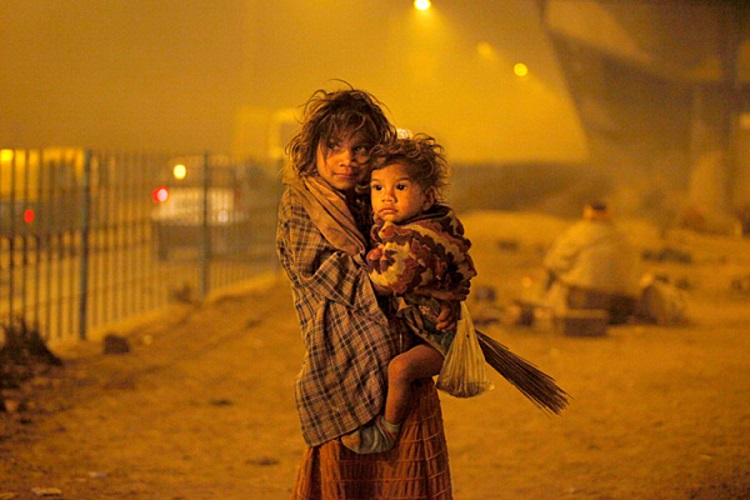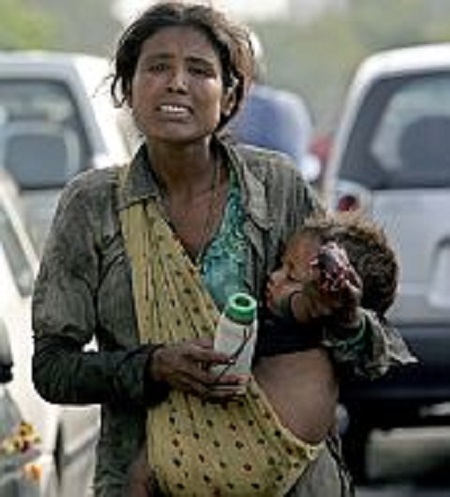Anxiety over the Coronavirus and the fear of death has united a billion plus India like never before, everyone and everything is off the streets, including those who live on footpaths and cannot work from home.
The Indian Capital — like other cities — has turned into a ghost town, everyone is extra careful to keep outsiders away from homes. Back off, back off, back off scream residents from their condominiums.
They are not allowing any outsider to enter their complexes. Newspaper hawkers, garbage collectors, grocery delivery boys and even nannies and maids are told to stay away. In some places, nurses have been asked to leave homes because residents fear they could carry the deadly virus. Doctors treating Coronavirus patients are mostly spending time in hospitals. When they return home, they face isolation and insults. Across the city, posters have come up identifying houses under quarantine, as if the house has leprosy patients. Panicky Indians have shared the 1977 Bee Gees chartbuster Stayin Alive through WhatsApp messages, many standing in their balconies with portable loudspeakers for a game of Tambola, also known as Housie. There is unity in beating the stress. Divide comes only when the poor come close.

Politicians, always squabbling over issues ranging from defence deals to court judgements to lack of funds for development projects, have suddenly united. Everyone is following diktats issued by the Central government, there is no opposition because of the fear of bearing the brunt of the pandemic’s unceasing spread. Every state government wants a low figure of Coronavirus patients. Why not? A higher figure would bring a stigma of a lifetime. Some states, sadly, have even started fudging numbers.
Experts feel India, under the BJP-led NDA government, has handled the crisis well in South Asia. India has nearly 500 cases, Pakistan — it has a large number of Chinese workers — has 1,000 plus cases, Sri Lanka has 95 cases, Bangladesh 27 cases and Nepal one case.
At the heart of the crisis is Delhi, once described by author Rana Dasgupta as a city living on its wheels (read powerful cars of powerful men). The fear has been a great leveller, the city is not witnessing anymore divided influence, no one is talking about newly acquired assets, no one is flaunting connections. Everyone is reminding the other that Italy’s total dead is more than 4,800, the most for a single country and a billion plus India — where a few have died — is still struggling to contain the virus. The virus has pushed India’s conspicuous consumers underground, they do not want to seek visibility. Rather than brag about their money or show it off, they are keeping quiet about their advantages, describing themselves as normal. No one wants to say they have returned from London or Spain, they are saying they have returned from next door Sonepat, even Vrindavan, home to India’s Love God Krishna.
India’s big, big distancing business has wreaked havoc on those who eat, sleep and live on the streets, among them the country’s half a million beggar population. For them, class never mattered. But now, their very existence has come under threat. So they want to be safe. On Monday night, right after Prime Minister Narendra Modi addressed the nation for a second time, violence erupted in a South Delhi neighbourhood where three girls from Manipur were taunted and pushed away from a grocery store because people in the market mistook them for Chinese. Among those triggering the chaos were doctors, engineers, bank employees, even rich real estate developers. Eventually, cops were called to escort the girls to their home. The girls were, obviously, shaken by the violent reaction. Elsewhere, residents had tried their best to kick out air hostesses and crew of airlines from the neighbourhoods, blaming them as carriers of Coronavirus. In some places, bank officials were ostracised. Across India, food delivery boys from Zomato and Swiggy were beaten up by security guards of residential complexes, not many realised that food is a part of the essential service which has been exempted from the lockdown. Keep them away, keep them away, keep them away, screamed panicky residents even as the security guards used fiberglass sticks to hit the delivery boys and smash their boxes.
The fear of death, claim social scientists, is driving Indians to a strange frenzy, everyone wants a gate with locks to keep outsiders away. They have found an excuse to enforce the government’s call for social distancing.
And then, there are other problems.
The Indian Capital does not have Soul Kitchens (like in Chennai or Mumbai) where the poor can come for meals throughout the day and night. Some volunteers are making efforts to supply cooked meals to the homeless who do not have the cash to go to departmental stores, do not have homes to work for offices. But such Samaritans are very low in numbers. Delhi CM Arvind Kejriwal has offered the homeless space in government shelters that will also offer food. But it is not enough to accommodate all the homeless. Worse, no definitive mapping has ever been done for the homeless in India. Hence, no one knows how many poor and homeless have been affected in the Coronavirus crisis.
Beggars, who form a large chunk of the homeless, are the most vulnerable. In normal times, they earned off the streets and cooked frugal meals at their makeshift homes near the highways, under the Capital’s gigantic flyovers. But now, they have all been shunted along with their children, who would play I-spy under streetlights. Everyone wants Delhi clean, everyone wants Delhi safe, everyone wants Delhi silent. There is, of course, justification in what the government and the cops are doing. There is also no justification at the way the poor have been left alone at the height of this gigantic crisis.
I was reminded of Shyam Bandhopadhyay, a retired clerk whom I met way back in 1999 in Kolkata who worked tirelessly to collect data on the city’s beggars, now estimated at a little over 45,000. Bandhopadhyay told me why it was important for the nation (read the government) to give dignity to the beggars and not leave them on the streets as nobodies. “Dignity is more important than a handful of coins people throw at the beggars,” said Bandhopadhyay, whose work drew praise from the city’s greatest humanitarian, Mother Teresa.

Bandhopadhyay reminded me about Kolkata’s author, Subodh Ghosh, whose short story about a beggar’s death shook the city’s conscience. The story went like this: A beggar was run over by a speeding truck. When he fell, coins he had collected scattered all over the road, blood-soaked coins a reflection of the beggar’s deep discomfort with life despite having a decent amount of cash. Bandhopadhyay reminded me how the rich remained elite and snobby, wore wealth on their sleeves but rarely came together to put in place a foolproof plan for the homeless. I remember Bandhopadhyay — fondly called Shyam Pagla by many in Kolkata — telling me why the poor should be the responsibility of the super-wealthy and not the government. “Government babus will never help the poor.”
Bandhopadhyay, lived in Howrah’s Salkia neighbourhood (a suburb of Calcutta) that lies close to the Hooghly river. Life was not a rags to riches story, it was nothing beyond rags. Still, he walked through the streets of Kolkata and collected data on beggars and homeless, rehabilitating more than 24,000 beggars. Bandhopadhyay told me how his life changed after he once saw two-time Congress legislator Mahadev Mukherjee begging on the platforms of Sealdah station. He had set up the world’s only Beggar Bureau, compiling fascinating research material on the world’s largest beggar population. In a life dedicated to destitutes, Shyam’s last wish also had a tinge of benevolence. Folded inside his starched dhoti was a small note that read: “I hereby authorise the Indian government to sell my skeleton to a foreign hospital and spend the proceeds for the welfare of beggars.”
Suddenly, I felt the need for a few Shyam Paglas in India.
In his second address to the nation, PM Narendra Modi exhorted Indians to keep themselves safe, and also help those who were the most vulnerable, people who were homeless, people who begged for their lives, people who lived on footpaths. The PM knew once the Coronavirus enters into people under Below Poverty Line (BPL), it would be a huge challenge to control it and a large chunk of India’s revenue would be required to be invested to handle the situation. Modi should know. India is home to 138 billionaires and the country’s culture has long been marked by questions about the moral calibre of wealthy people. In India, Capitalist entrepreneurs are often celebrated, but they are also represented as greedy and ruthless. Inheritors of fortunes, especially women, are portrayed as glamorous, but also as self-indulgent.
The Coronavirus crisis has suddenly brought up the negative side of this high inequality where the poor are left to fend for themselves. Majority of India does not want a real neighborhood existence. People have their justification in place. The government has announced a nationwide lockdown, which includes travel restrictions and the closure of most stores apart from groceries and pharmacies. The government (read the PM) has asked Indians to take care of the poor and the homeless.
But the majority are not keen to follow the Prime Minister’s diktat. The poor is the responsibility of the government, no one else. After all, everyone wants to keep Coronavirus statistics in control, the homeless must stay out of the iron gates.
The government has displayed hope for all. There will be an unprecedented financial package to help recover from a sudden economic arrest, with businesses shuttered and consumers limiting their spending to groceries and household essentials. That’s meant for those in the WFH (work from home) category. Streets are homes to the homeless. WTF does not apply to them, WFH does not apply to them. They fill a new category that has emerged in India. It is WATH, or Why Are They Here?

